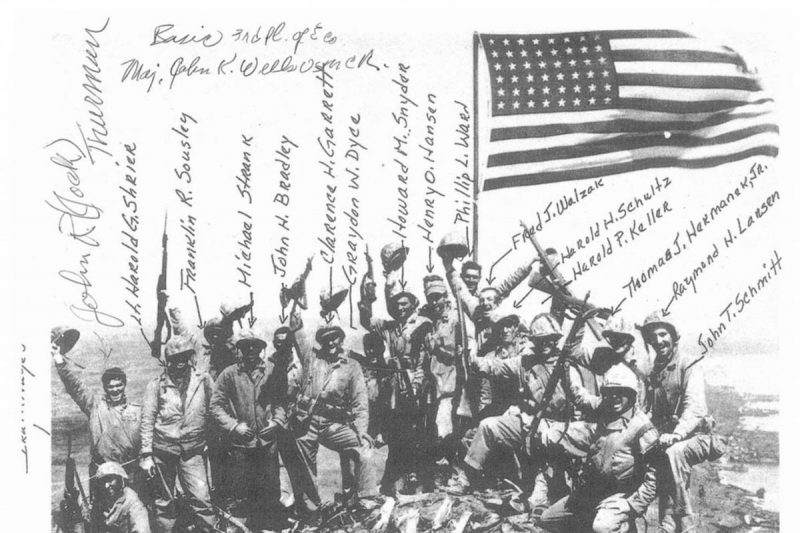In a statement made Wednesday, the US Marine Corps said that it had misidentified two Marines that helped to raise one of the flags atop Mount Suribachi after the long and ferocious battle for the island of Iwo Jima.
This news comes after only two months since the Marine Corps announced they had accidentally misidentified one of the men who helped raise the second flag. The photograph was shot by Joe Rosenthal and won the Pulitzer Prize.
The raising of the two flags, and the men that did so on Feb. 23, 1945, has become a part of Marine Corps lore. But since the publication of an Omaha World-Herald article in 2014 by two amateur historians that showed that one of the men in Rosenthal’s iconic picture had been misidentified, the details of that day have come under scrutiny.
The Marine Corps announced back in May that they had started to look into Rosenthal’s photograph after inquiries by filmmakers. A panel – led by a retired Marine general – concluded that the marine in the raising of the second flag – who had been identified as Mate James Bradley – was actually a Marine private from Detroit named Harold Schultz. Bradley was a recipient of a Navy Cross and was the subject of his son’s book (later turned movie) Flags of our Fathers. He was actually in the lesser known first flag raising.
After their investigation into the second flag raising, the same panel turned their attention to the first flag. They used some of the same photographic evidence and material for the first inquiry.
They came to the conclusion that Pfc. Louis C. Charlo and Pfc. James R. Michels were not part of the initial flag-raising. Charlo participated in a four-man recon patrol that went up Suribachi and Michels held perimeter security while the first flag was raised.
The director of Marines’ History Division, Charles P. Neimeyer, said that the Marine Corps was first approached by an independent researcher in 2011. The researcher had evidence that Michels and Charlo were not in the initial flag-raising, and after the investigation, they thought it prudent that they update their records.
The men who raised the first flag were 1st Lt. Harold G. Schrier, PhM2c John H. Bradley, Sgt. Ernest I. Thomas Jr., Sgt. Henry O. Hansen, Cpl. Charles W. Lindberg, and Pvt. Philip L. Ward.
There were no pictures taken of the first flag going up, yet the sight of the first flag going up was much more significant to the marines fighting below. The first flag going up was the first sign that they had seized the island’s most significant piece of terrain. The only camera on the summit while the flag was being raised was owned by Staff Sgt. Louis Lowery, a Marine combat photographer with Leatherneck Magazine. Unfortunately, Lowery was reloading film while the flag was hoisted skyward.
“Our history is important, and we owe it to our Marines and their families to ensure it is as accurate as possible. After we reviewed the second flag raising and found inconsistencies, we wanted to take another look at the first flag raising to make sure we had it correct,” said Marine Corps Commandant Gen. Robert Neller in a statement.
During the waning months of World War II, and while the B-29 Superfortresses were regularly dropping bombs on mainland Japan, the United States thought that the lone airstrip of Iwo Jima was the perfect place for damaged planes to land on their flights back to the Northern Mariana Islands.
Operation Detachment, the operation to seize the island of Iwo Jima, would last just over a month. 5,000 US Marines and 21,000 Japanese soldiers paid the ultimate cost in the battle for this tiny island in the Pacific.
The Marines had fought nearly four days before the flags went up on Feb. 23rd. Japanese snipers and machine gun nests were dug in deep around the base of Suribachi. Pounded mercilessly, the marines slowly made their way to the base of the 550-foot tall mountain. However, on February 23, the recon patrol that scaled the mountain ran into no resistance, according to Marine documents.
As the recon team made their way down the mountain, a 30-man patrol from Echo Company 2nd Battalion, 28th Marine Regiment, led by 1st Lt. Harold G. Schrier, started to make their way up Suribachi. A small American flag was given to Schrier, and he was told to make sure the flag was taken up the mountain.
On Feb. 23, 1945, around 10:30 A.M. the first flag was raised over Iwo Jima. Ships that were offshore could see the flag and sounded their horns as Marines looked up from their foxholes and watched to see their flag waving high above them. Neimeyer said that over the years many of the eyewitnesses remembered the first flag going up, but almost no one had an exact time on when the second one was raised.
